Development of an RT-LAMP Assay for Detecting tet(M) in Enterococcus Species: Enhancing AMR Surveillance Within the One Health Sectors
Abstract
1. Introduction
2. Materials and Methods
2.1. Bacterial Strains
2.2. DNA Extraction for RT-LAMP Development
2.3. Designation of LAMP Primers
2.4. Multiplex PCR for the Detection of Tetracycline Resistance Genes in Enterococci
2.5. Optimization of LAMP for the tet(M) Resistance Gene in Different Reaction Conditions
2.6. Specificity and Sensitivity of the tet(M) RT-LAMP Method
2.7. LAMP Validation on tet(M)-Positive Enterococcus Species
2.8. Evaluation of the tet(M) RT-LAMP Assay in Spiked Human and Animal Urine Samples
3. Results
3.1. Optimization of tet(M) RT-LAMP Assay at Different Temperatures
3.2. Optimization of tet(M) RT-LAMP Assay at Different Reaction Times
3.3. Determination of the Specificity and Sensitivity of RT-LAMP Compared to Conventional PCR Method
3.3.1. Specificity Testing of RT-LAMP
3.3.2. Sensitivity Testing
3.4. Validation of the tet(M) RT-LAMP Assay with Human and Animal Urine Samples Spiked with Enterococcus Species
4. Discussion
5. Conclusions
Supplementary Materials
Author Contributions
Funding
Institutional Review Board Statement
Informed Consent Statement
Data Availability Statement
Acknowledgments
Conflicts of Interest
References
- Cattoir, V. The multifaceted lifestyle of enterococci: Genetic diversity, ecology and risks for public health. Curr. Opin. Microbiol. 2022, 65, 73–80. [Google Scholar] [CrossRef] [PubMed]
- Makarov, D.A.; Ivanova, O.E.; Pomazkova, A.V.; Egoreva, M.A.; Prasolova, O.V.; Lenev, S.V.; Gergel, M.A.; Bukova, N.K.; Karabanov, S.Y. Antimicrobial resistance of commensal Enterococcus faecalis and Enterococcus faecium from food-producing animals in Russia. Vet. World 2022, 15, 611–621. [Google Scholar] [CrossRef]
- Huys, G.; D’Haene, K.; Collard, J.-M.; Swings, J. Prevalence and molecular characterization of tetracycline resistance in Enterococcus isolates from food. Appl. Environ. Microbiol. 2004, 70, 1555–1562. [Google Scholar] [CrossRef] [PubMed]
- Iancu, A.-V.; Arbune, M.; Zaharia, E.-A.; Tutunaru, D.; Maftei, N.-M.; Peptine, L.-D.; Țocu, G.; Gurău, G. Prevalence and Antibiotic Resistance of Enterococcus spp.: A Retrospective Study in Hospitals of Southeast Romania. Appl. Sci. 2023, 13, 3866. [Google Scholar] [CrossRef]
- Zaheer, R.; Cook, S.R.; Barbieri, R.; Goji, N.; Cameron, A.; Petkau, A.; Polo, R.O.; Tymensen, L.; Stamm, C.; Song, J. Surveillance of Enterococcus spp. reveals distinct species and antimicrobial resistance diversity across a One-Health continuum. Sci. Rep. 2020, 10, 3937. [Google Scholar]
- Tian, Y.; Yu, H.; Wang, Z. Distribution of acquired antibiotic resistance genes among Enterococcus spp. isolated from a hospital in Baotou, China. BMC Res. Notes 2019, 12, 27. [Google Scholar] [CrossRef]
- Rana, D.; Sande, S. Study of prevalence and antimicrobial susceptibility pattern of enterococci isolated from clinically relevant samples with special reference to high level aminoglycoside resistance (HLAR) in a rural tertiary care hospital. J. Evol. Med. Dent. Sci. 2020, 9, 2472–2478. [Google Scholar] [CrossRef]
- Moussa, A.A.; Md Nordin, A.F.; Hamat, R.A.; Jasni, A.S. High level aminoglycoside resistance and distribution of the resistance genes in Enterococcus faecalis and Enterococcus faecium from teaching hospital in Malaysia. Infect. Drug Resist. 2019, 12, 3269–3274. [Google Scholar] [CrossRef]
- Mussa, E.A.M.; Alsalahi, A.; Aljaberi, M.A.; Jasni, A.S.; Desa, M.N.M.; Al-Mahdi, A.Y.M.; Hamat, R.A. Acquired tetracycline resistance genes by transposons and virulence factors in enterococci recovered from overland and aquatic animals: A systematic review. Rev. Aquac. 2022, 14, 399–413. [Google Scholar] [CrossRef]
- Robles-Jimenez, L.E.; Aranda-Aguirre, E.; Castelan-Ortega, O.A.; Shettino-Bermudez, B.S.; Ortiz-Salinas, R.; Miranda, M.; Li, X.; Angeles-Hernandez, J.C.; Vargas-Bello-Pérez, E.; Gonzalez-Ronquillo, M. Worldwide traceability of antibiotic residues from livestock in wastewater and soil: A systematic review. Animals 2021, 12, 60. [Google Scholar] [CrossRef]
- LaPlante, K.L.; Dhand, A.; Wright, K.; Lauterio, M. Re-establishing the utility of tetracycline-class antibiotics for current challenges with antibiotic resistance. Ann. Med. 2022, 54, 1686–1700. [Google Scholar] [CrossRef]
- Tsai, H.-Y.; Lee, Y.-L.; Liu, P.-Y.; Lu, M.-C.; Shao, P.-L.; Lu, P.-L.; Cheng, S.-H.; Ko, W.-C.; Lin, C.-Y.; Wu, T.-S. Antimicrobial susceptibility of bacteremic vancomycin-resistant Enterococcus faecium to eravacycline, omadacycline, lipoglycopeptides, and other comparator antibiotics: Results from the 2019–2020 Nationwide Surveillance of Multicenter Antimicrobial Resistance in Taiwan (SMART). Int. J. Antimicrob. Agents 2021, 58, 106353. [Google Scholar] [PubMed]
- Chua, M.F.P.; Nida, S.S.; Lawhorn, J.; Sundareshan, V. 1586. A Comparative Analysis of In Vitro Susceptibilities of Vancomycin-Resistant Enterococci Against Doxycycline, Minocycline, Tigecycline, Eravacycline and Omadacycline. Open Forum Infect. Dis. 2020, 7, S790. [Google Scholar] [CrossRef]
- He, T.; Wang, R.; Liu, D.; Walsh, T.R.; Zhang, R.; Lv, Y.; Ke, Y.; Ji, Q.; Wei, R.; Liu, Z. Emergence of plasmid-mediated high-level tigecycline resistance genes in animals and humans. Nat. Microbiol. 2019, 4, 1450–1456. [Google Scholar] [CrossRef] [PubMed]
- World Health Organization. Antimicrobial Resistance. In Global Report on Surveillance 2014; World Health Organization: Geneva, Switzerland, 2014. [Google Scholar]
- World Health Organization. Global Antimicrobial Resistance Surveillance System (GLASS): Molecular Methods for Antimicrobial Resistance (AMR) Diagnostics to Enhance the Global Antimicrobial Resistance Surveillance System. In Global Antimicrobial Resistance Surveillance System (GLASS): Molecular Methods for Antimicrobial Resistance (AMR) Diagnostics to Enhance the Global Antimicrobial Resistance Surveillance System; World Health Organization: Geneva, Switzerland, 2019. [Google Scholar]
- Abushaheen, M.A.; Muzaheed; Fatani, A.J.; Alosaimi, M.; Mansy, W.; George, M.; Acharya, S.; Rathod, S.; Divakar, D.D.; Jhugroo, C.; et al. Antimicrobial resistance, mechanisms and its clinical significance. Disease-a-Month 2020, 66, 100971. [Google Scholar] [CrossRef]
- Al-Tammemi, A.a.B.; Kanaan, D.a.; Omar, A.; Barakat, M. Tackling Antimicrobial Resistance in Jordan: Bridging Science, Research, and Policy for a Healthier Future. Jordan J. Appl. Sci.-Nat. Sci. Ser. 2025, 19, 1–3. [Google Scholar] [CrossRef]
- One Health High-Level Expert Panel (OHHLEP); Adisasmito, W.B.; Almuhairi, S.; Behravesh, C.B.; Bilivogui, P.; Bukachi, S.A.; Casas, N.; Cediel Becerra, N.; Charron, D.F.; Chaudhary, A.; et al. One Health: A new definition for a sustainable and healthy future. PLoS Pathog. 2022, 18, e1010537. [Google Scholar] [CrossRef]
- Mori, Y.; Notomi, T. Loop-mediated isothermal amplification (LAMP): A rapid, accurate, and cost-effective diagnostic method for infectious diseases. J. Infect. Chemother. 2009, 15, 62–69. [Google Scholar] [CrossRef]
- Huang, W.; Zhang, Q.; Li, W.; Chen, Y.; Shu, C.; Li, Q.; Zhou, J.; Ye, C.; Bai, H.; Sun, W.; et al. Anti-outer Membrane Vesicle Antibodies Increase Antibiotic Sensitivity of Pan-Drug-Resistant Acinetobacter baumannii. Front. Microbiol. 2019, 10, 1379. [Google Scholar] [CrossRef]
- Yamamoto, N.; Hamaguchi, S.; Akeda, Y.; Santanirand, P.; Kerdsin, A.; Seki, M.; Ishii, Y.; Paveenkittiporn, W.; Bonomo, R.A.; Oishi, K.; et al. Clinical Specimen-Direct LAMP: A Useful Tool for the Surveillance of blaOXA-23-Positive Carbapenem-Resistant Acinetobacter baumannii. PLoS ONE 2015, 10, e0133204. [Google Scholar] [CrossRef]
- Mu, X.-Q.; Liu, B.-B.; Hui, E.; Huang, W.; Yao, L.-C.; Duo, L.-B.; Sun, W.-Y.; Li, G.-Q.; Wang, F.-X.; Liu, S.-L. A rapid loop-mediated isothermal amplification (LAMP) method for detection of the macrolide–streptogramin type B resistance gene msrA in Staphylococcus aureus. J. Glob. Antimicrob. Resist. 2016, 7, 53–58. [Google Scholar] [CrossRef]
- Ng, L.-K.; Martin, I.; Alfa, M.; Mulvey, M. Multiplex PCR for the detection of tetracycline resistant genes. Molecular and Cellular Probes. 2001, 15, 209–215. [Google Scholar] [CrossRef]
- Aglietti, C.; Luchi, N.; Pepori, A.L.; Bartolini, P.; Pecori, F.; Raio, A.; Capretti, P.; Santini, A. Real-time loop-mediated isothermal amplification: An early-warning tool for quarantine plant pathogen detection. AMB Express 2019, 9, 50. [Google Scholar] [CrossRef] [PubMed]
- Bowen, V.T.; Volchok, H.L. Spiked sample standards; their uses and disadvantages in analytical quality control. Environ. Int. 1980, 3, 365–376. [Google Scholar] [CrossRef]
- Notomi, T.; Okayama, H.; Masubuchi, H.; Yonekawa, T.; Watanabe, K.; Amino, N.; Hase, T. Loop-mediated isothermal amplification of DNA. Nucleic Acids Res. 2000, 28, e63. [Google Scholar] [CrossRef] [PubMed]
- Njiru, Z.K.; Mikosza, A.S.J.; Armstrong, T.; Enyaru, J.C.; Ndung’u, J.M.; Thompson, A.R.C. Loop-mediated isothermal amplification (LAMP) method for rapid detection of Trypanosoma brucei rhodesiense. PLoS Neglected Trop. Dis. 2008, 2, e147. [Google Scholar] [CrossRef]
- Simon, A.S.; Subbiah, S.K.; Than, L.T.L.; Osman, M.; Hamat, R.A. Improved Visual Detection of speB Gene in Streptococcus pyogenes Isolates by Real-time Loop-Mediated Isothermal Amplification Turbidimetry Method. Jundishapur J. Microbiol. (JJM) 2021, 14, e108540. [Google Scholar] [CrossRef]
- Byappanahalli, M.N.; Nevers, M.B.; Korajkic, A.; Staley, Z.R.; Harwood, V.J. Enterococci in the environment. Microbiol. Mol. Biol. Rev. 2012, 76, 685–706. [Google Scholar] [CrossRef]
- Bambic, D.; McBride, G.; Miller, W.; Stott, R.; Wuertz, S. Quantification of Pathogens and Sources of Microbial Indicators for QMRA in Recreational Waters; Water Intelligence Online, IWA Publishing: London, UK, 2011; Volume 10, pp. 1–136. [Google Scholar]
- Courtois, S.; Do Quang, Z.; Bergeron, P.; Massé, P. Reducing the health risk by using rapid quantification methods for the monitoring of E. coli and Enterococci in bathing waters. Water Pract. Technol. 2009, 4, wpt2009073. [Google Scholar] [CrossRef]
- Tyson, G.H.; Nyirabahizi, E.; Crarey, E.; Kabera, C.; Lam, C.; Rice-Trujillo, C.; McDermott, P.F.; Tate, H. Prevalence and antimicrobial resistance of enterococci isolated from retail meats in the United States, 2002 to 2014. Appl. Environ. Microbiol. 2018, 84, e01902-17. [Google Scholar] [CrossRef]
- Yamanaka, H.; Kadomatsu, R.; Takagi, T.; Ohsawa, M.; Yamamoto, N.; Kubo, N.; Takemoto, T.; Ohsawa, K. Antimicrobial resistance profiles of vancomycin-resistant Enterococcus species isolated from laboratory mice. J. Vet. Sci. 2019, 20, e13. [Google Scholar] [CrossRef] [PubMed]
- Amador, P.; Fernandes, R.; Prudêncio, C.; Duarte, I. Prevalence of antibiotic resistance genes in multidrug-resistant Enterobacteriaceae on Portuguese livestock manure. Antibiotics 2019, 8, 23. [Google Scholar] [CrossRef]
- Roberts, M.C. Tetracyclines: Mode of action and their bacterial mechanisms of resistance. In Bacterial Resistance to Antibiotics—From Molecules to Man; John Wiley & Sons Ltd.: Hoboken, NJ, USA, 2019; pp. 101–124. [Google Scholar]
- Johnson, C.N.; Sheriff, E.K.; Duerkop, B.A.; Chatterjee, A. Let me upgrade you: Impact of mobile genetic elements on enterococcal adaptation and evolution. J. Bacteriol. 2021, 203, e00177-21. [Google Scholar] [CrossRef] [PubMed]
- Chattopadhyay, M.K. Use of antibiotics as feed additives: A burning question. Front. Microbiol. 2014, 5, 334. [Google Scholar] [CrossRef]
- Agga, G.E.; Cook, K.L.; Netthisinghe, A.M.; Gilfillen, R.A.; Woosley, P.B.; Sistani, K.R. Persistence of antibiotic resistance genes in beef cattle backgrounding environment over two years after cessation of operation. PLoS ONE 2019, 14, e0212510. [Google Scholar] [CrossRef] [PubMed]
- Jaroszewski, J.; Mamun, N.; Czaja, K. Bidirectional interaction between tetracyclines and gut microbiome. Antibiotics 2023, 12, 1438. [Google Scholar] [CrossRef]
- Aoi, Y.; Hosogai, M.; Tsuneda, S. Real-time quantitative LAMP (loop-mediated isothermal amplification of DNA) as a simple method for monitoring ammonia-oxidizing bacteria. J. Biotechnol. 2006, 125, 484–491. [Google Scholar] [CrossRef]
- Huang, Q.-Q.; Liu, B.-B.; Zhu, H.-F.; Ma, J.-J.; Tsoi, M.; Yao, B.-Q.; Yao, L.-C.; Wu, Q.; Mu, X.-Q.; Liu, S.-L. Rapid and sensitive detection of the vanA resistance gene from clinical Enterococcus faecium and Enterococcus faecalis isolates by loop-mediated isothermal amplification. J. Glob. Antimicrob. Resist. 2019, 16, 262–265. [Google Scholar] [CrossRef]
- Hu, H.X.; Shen, S.B.; Jiang, J.L.; Wang, W.L.; Teng, T.Y.; Zhu, Z.Z. Establishment of a real-time turbidimeter-based loop-mediated isothermal amplification for detection of Vibrio cholera in seafood. J. Henan Agric. Sci. 2014, 43, 127–130. [Google Scholar]
- Mori, Y.; Nagamine, K.; Tomita, N.; Notomi, T. Detection of loop-mediated isothermal amplification reaction by turbidity derived from magnesium pyrophosphate formation. Biochem. Biophys. Res. Commun. 2001, 289, 150–154. [Google Scholar] [CrossRef]
- Chen, G.; Chen, L.; Lin, S.; Yang, C.; Liang, H.; Huang, K.; Guo, Z.; Lv, F. Sensitive and rapid detection of tet(X2) ~ tet(X5) by loop-mediated isothermal amplification based on visual OTG dye. BMC Microbiol. 2023, 23, 329. [Google Scholar] [CrossRef] [PubMed]
- Shirato, K. Detecting amplicons of loop-mediated isothermal amplification. Microbiol. Immunol. 2019, 63, 407–412. [Google Scholar] [CrossRef] [PubMed]
- Gadkar, V.J.; Goldfarb, D.M.; Gantt, S.; Tilley, P.A. Real-time detection and monitoring of loop mediated amplification (LAMP) reaction using self-quenching and de-quenching fluorogenic probes. Sci. Rep. 2018, 8, 5548. [Google Scholar] [CrossRef] [PubMed]
- Ezzeddine, Z.; Ghssein, G. Towards new antibiotics classes targeting bacterial metallophores. Microb. Pathog. 2023, 182, 106221. [Google Scholar] [CrossRef]
- Luo, S.; Li, X.-R.; Gong, X.-T.; Kulikovsky, A.; Qu, F.; Beis, K.; Severinov, K.; Dubiley, S.; Feng, X.; Dong, S.-H.; et al. Trojan horse peptide conjugates remodel the activity spectrum of clinical antibiotics. Proc. Natl. Acad. Sci. USA 2025, 122, e2319483121. [Google Scholar] [CrossRef]
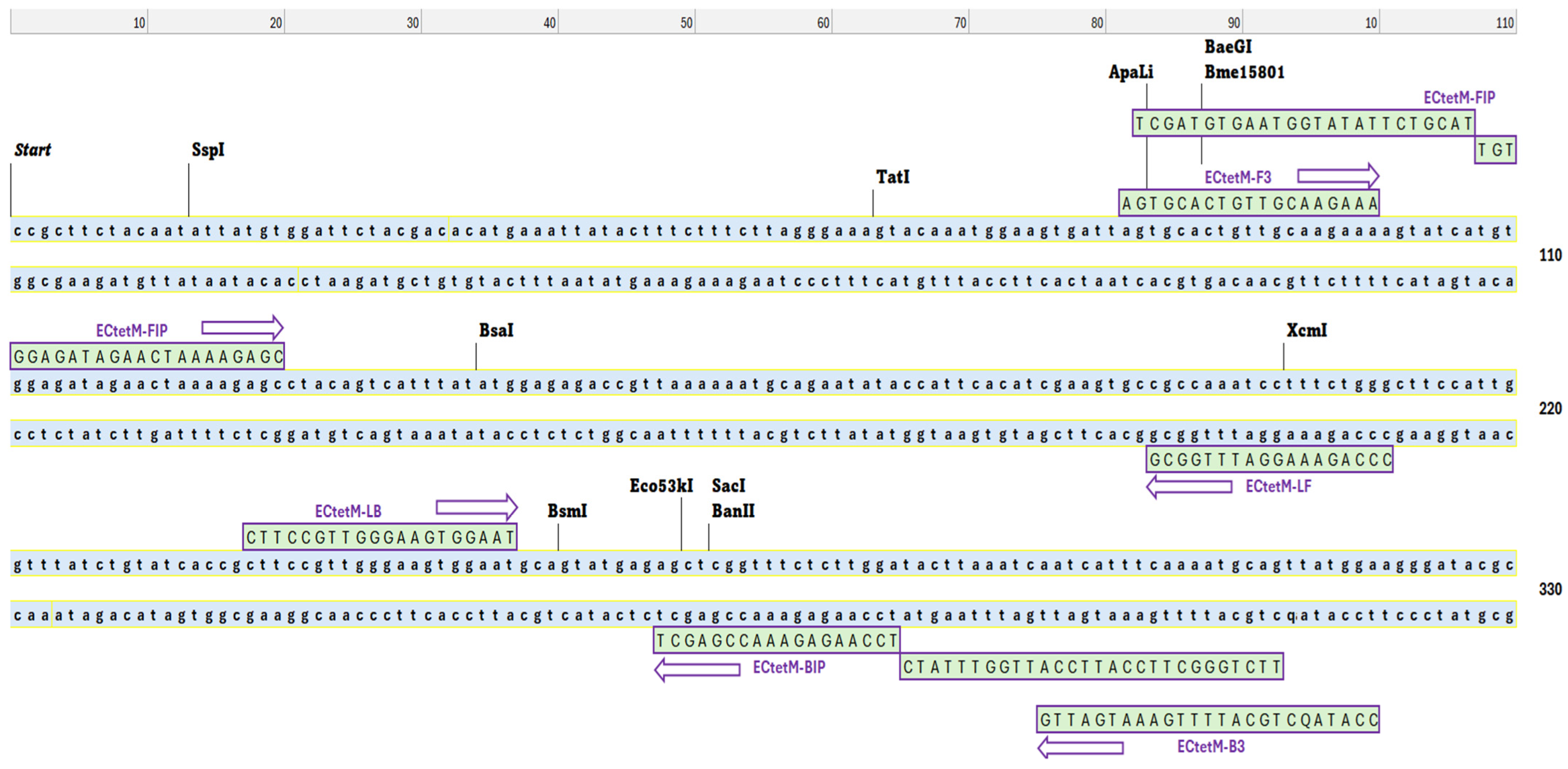

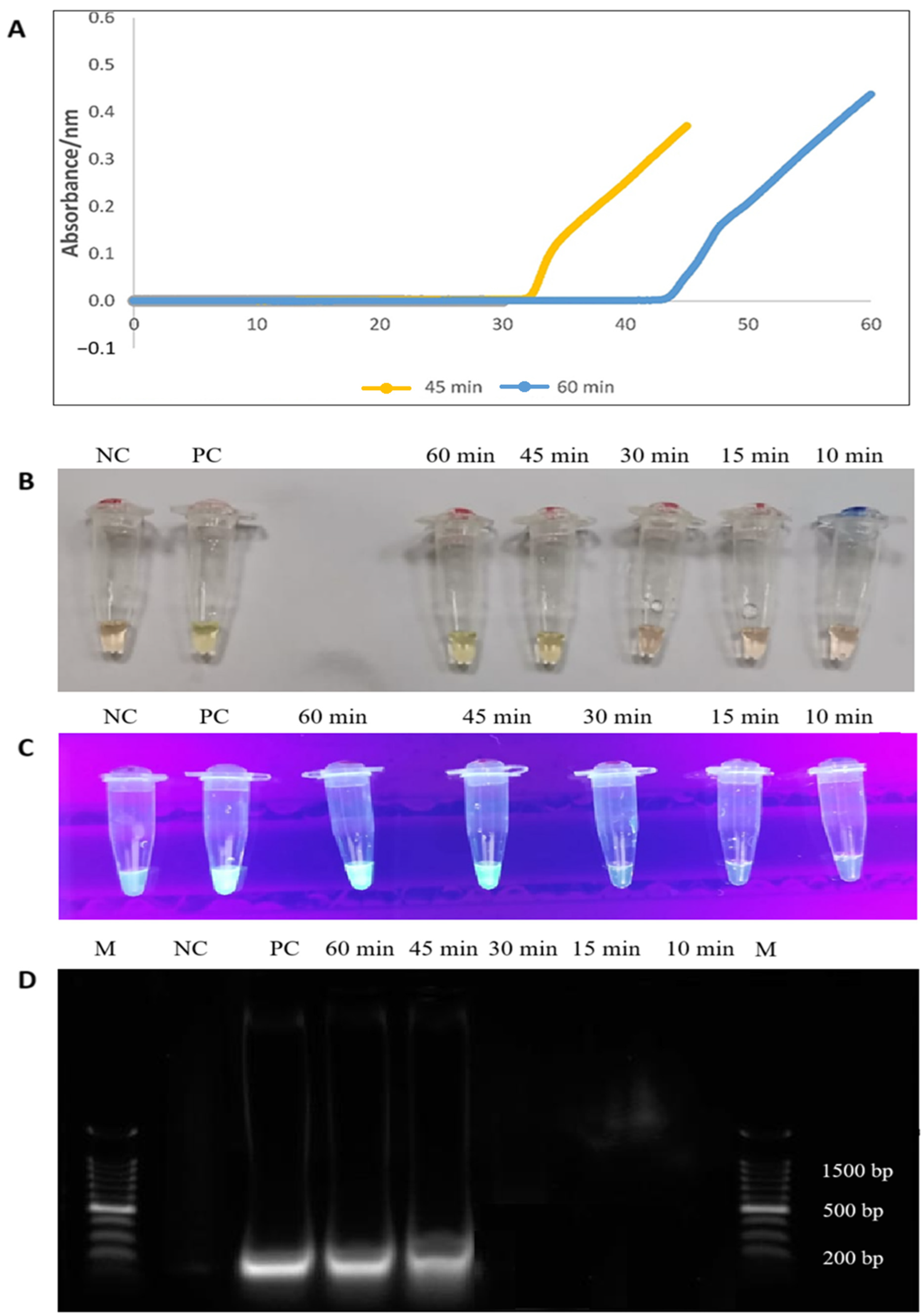
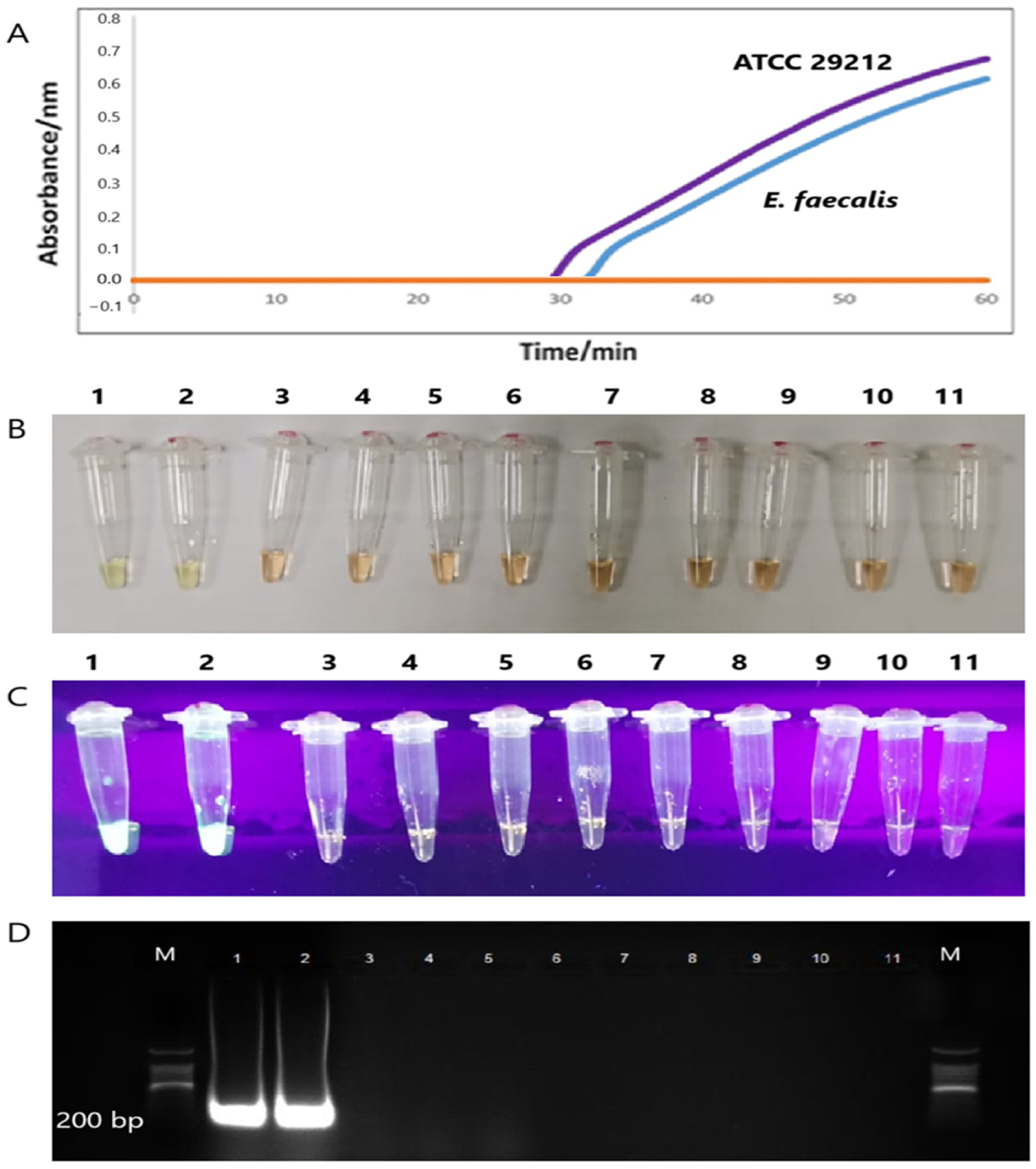
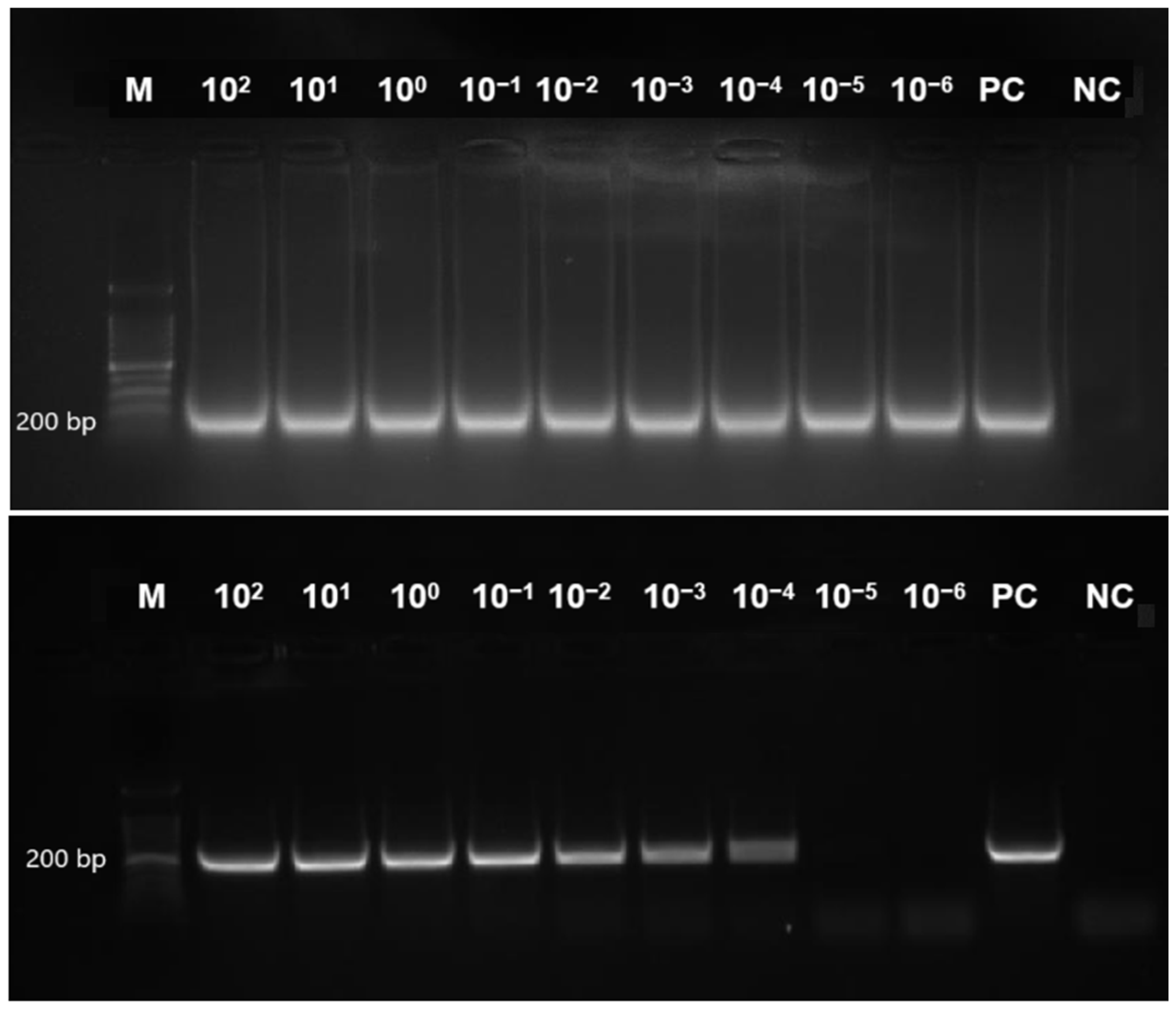
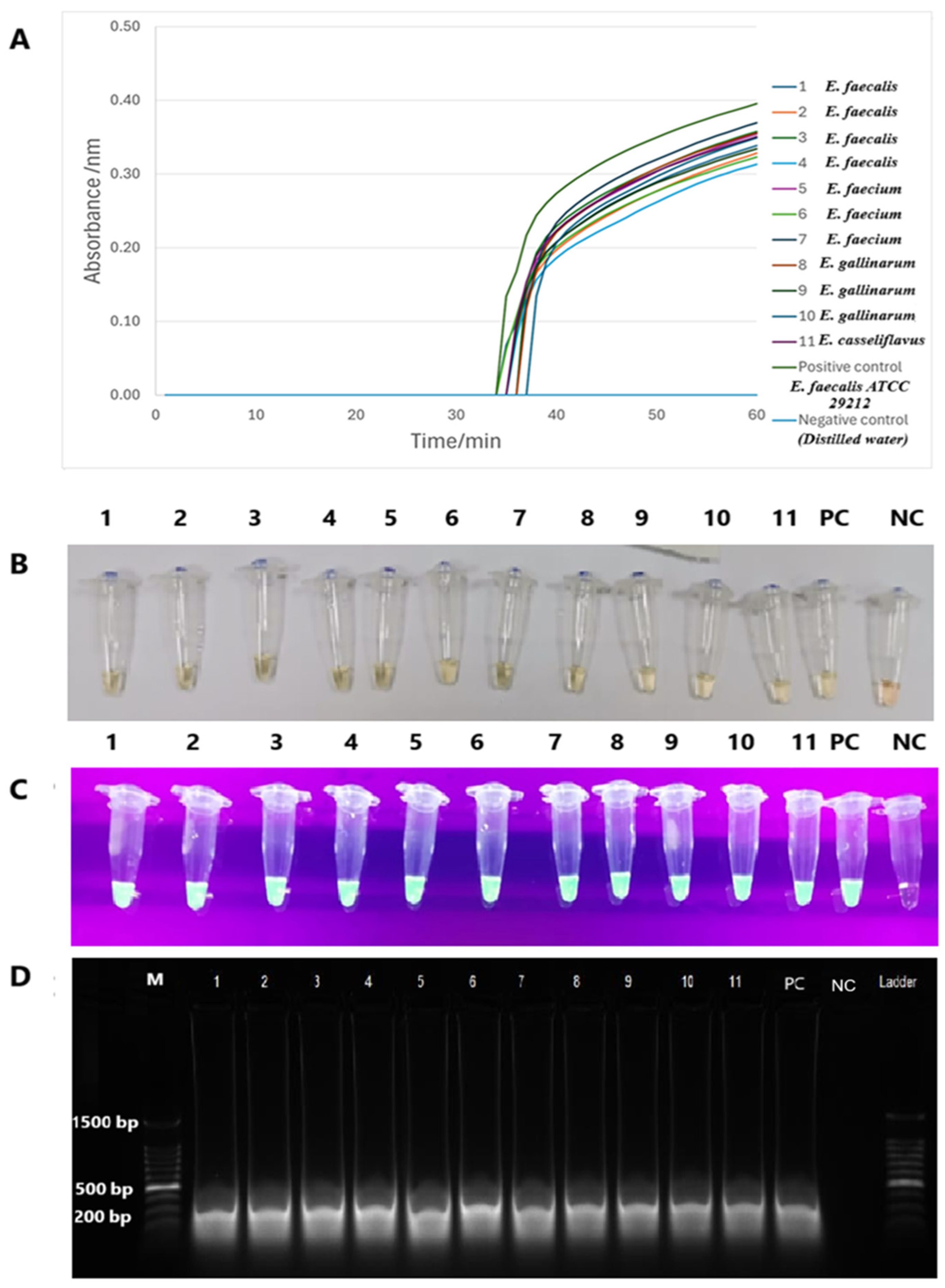
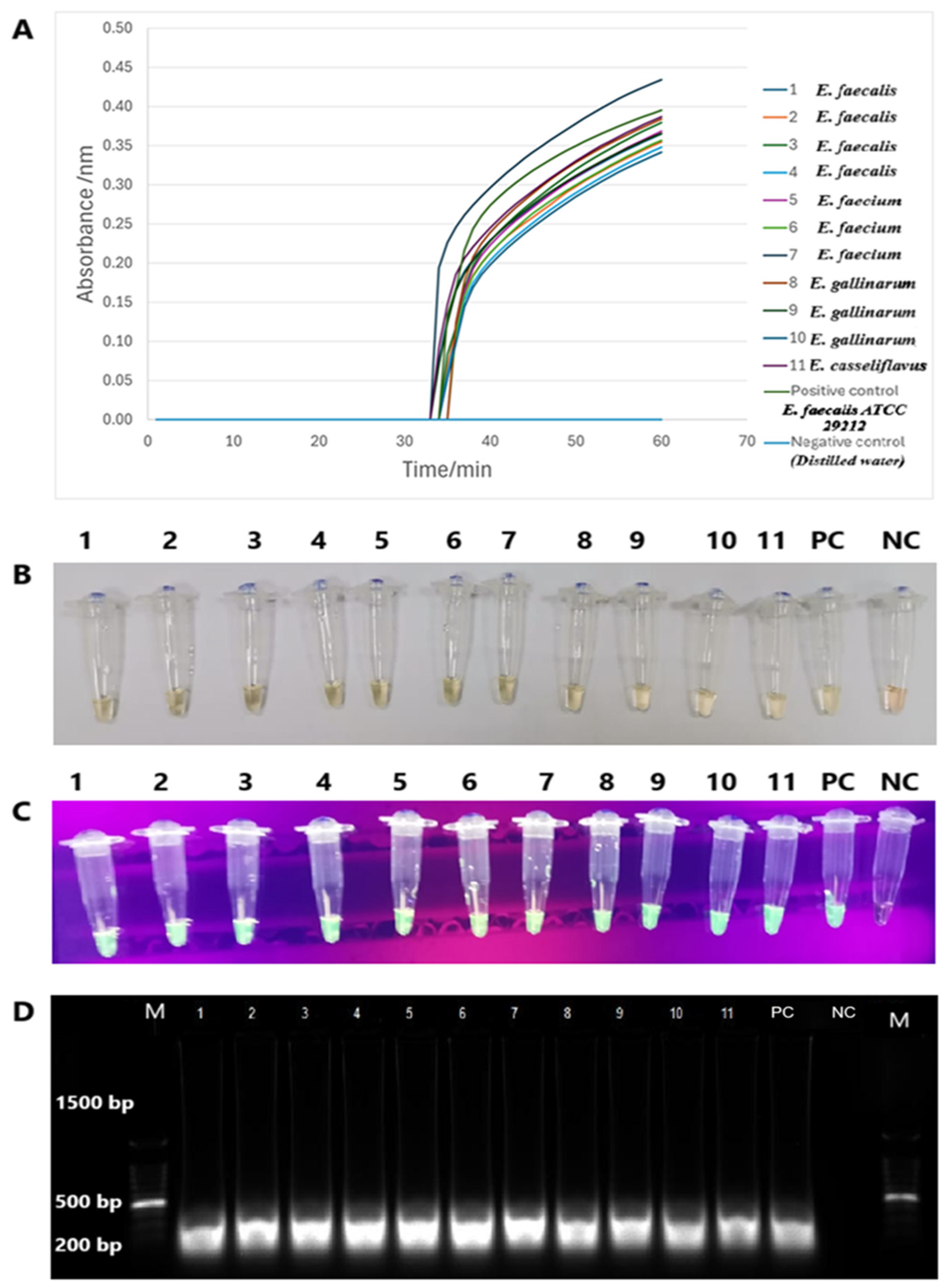
| Primer | Sequence | Size (BP) |
|---|---|---|
| F3 | 5′-AGT-ATC-ATG-TGG-AGA-TAG-AACT-3′ | 22 |
| B3 | 5′-CCA-TAA-CTG-CAT-TTT-GAA-ATG-ATTG-3′ | 25 |
| FIP | 5′-GGCACTTCGATGTGAATGGTATAT-TAGCCTACAGTCATTTATATGGAG-3′ | 48 |
| BIP | 5′-GCCAAATCCTTTCTGGGCTTCACC-GAGCTCTCATACTGC-3′ | 39 |
| LF | 5′-CCCAGAAAGGATTTGGCG-3′ | 18 |
| LB | 5′-CTTCCGTTGGGAAGTGGAAT-3′ | 20 |
| Gene | Primer Sequence | Base Pair | Reference |
|---|---|---|---|
| tet(L) | FW 5′-TCG TTA GCG TGC TGT CAT TC-3′ RV 5′-GTA TCC CAC CAA TGT AGC CG-3′ | 267 | [3] |
| tet(M) | FW 5′-GTTAAATAGTGTTCTTGGAGA-3′ RV 5′-CTAAGATATGGCTCTAACAAA-3′ | 517 | [4] |
| Bacterial Strain | Source |
|---|---|
| Enterococcus faecalis | ATCC 29212 |
| Enterococcus faecalis | Clinical isolate |
| Staphylococcus. aureus | ATCC25923 |
| Klebsiella pneumoniae | ATCC 700603 |
| Streptococcus pyogenes | ATCC 19615 |
| Streptococcus agalactiae | NCTC8017 |
| Escherichia coli | ATCC 25922 |
| Pseudomonas aeruginosa | ATCC 27853 |
| Klebsiella pneumoniae | ATCC1705 |
| Enterococcus faecalis | Clinical isolate (EF50) |
| Enterococcus gallinarum | Clinical isolate (EG90) |
Disclaimer/Publisher’s Note: The statements, opinions and data contained in all publications are solely those of the individual author(s) and contributor(s) and not of MDPI and/or the editor(s). MDPI and/or the editor(s) disclaim responsibility for any injury to people or property resulting from any ideas, methods, instructions or products referred to in the content. |
© 2025 by the authors. Licensee MDPI, Basel, Switzerland. This article is an open access article distributed under the terms and conditions of the Creative Commons Attribution (CC BY) license (https://creativecommons.org/licenses/by/4.0/).
Share and Cite
Mussa, E.A.M.; Al-Maleki, A.R.; Aljaberi, M.A.; Alsalahi, A.; Desa, M.N.M.; Jasni, A.S.; Ramanoon, S.Z.; Abdallah, A.M.; Hamat, R.A. Development of an RT-LAMP Assay for Detecting tet(M) in Enterococcus Species: Enhancing AMR Surveillance Within the One Health Sectors. Diagnostics 2025, 15, 1213. https://doi.org/10.3390/diagnostics15101213
Mussa EAM, Al-Maleki AR, Aljaberi MA, Alsalahi A, Desa MNM, Jasni AS, Ramanoon SZ, Abdallah AM, Hamat RA. Development of an RT-LAMP Assay for Detecting tet(M) in Enterococcus Species: Enhancing AMR Surveillance Within the One Health Sectors. Diagnostics. 2025; 15(10):1213. https://doi.org/10.3390/diagnostics15101213
Chicago/Turabian StyleMussa, Ebthag A. M., Anis Rageh Al-Maleki, Musheer A. Aljaberi, Abdulsamad Alsalahi, Mohd Nasir Mohd Desa, Azmiza Syawani Jasni, Siti Zubaidah Ramanoon, Atiyeh M. Abdallah, and Rukman Awang Hamat. 2025. "Development of an RT-LAMP Assay for Detecting tet(M) in Enterococcus Species: Enhancing AMR Surveillance Within the One Health Sectors" Diagnostics 15, no. 10: 1213. https://doi.org/10.3390/diagnostics15101213
APA StyleMussa, E. A. M., Al-Maleki, A. R., Aljaberi, M. A., Alsalahi, A., Desa, M. N. M., Jasni, A. S., Ramanoon, S. Z., Abdallah, A. M., & Hamat, R. A. (2025). Development of an RT-LAMP Assay for Detecting tet(M) in Enterococcus Species: Enhancing AMR Surveillance Within the One Health Sectors. Diagnostics, 15(10), 1213. https://doi.org/10.3390/diagnostics15101213






